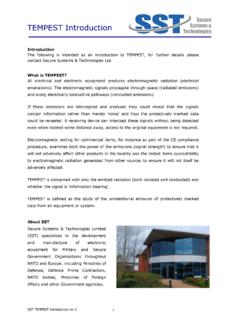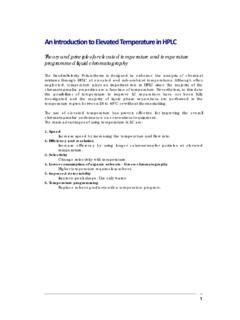Transcription of Introduction to Wireless Technology - …
1 1 Introduction to Wireless Technology2 Increasing number of mobile radio communication systems used in everyday life. Garage door openers, remote controllers for home entertainment equipment, cordless telephones, hand-held walkie-talkies, pagers, and cellular telephones are all examples of mobile radio communication systems. However, the cost, complexity, performance, and types of services offered by each of these mobile systems are to Wireless Technology3 Introduction to Wireless Technology The term Wireless communication refers to the transfer of information using electromagnetic (EM) or acoustic waves over the atmosphere rather than using any propagation medium that employs wires.
2 Not requiring an explicit network of wires and permitting communication while on the move Fortunately, EM waves travel with the speed of light in free space and inside medium (cables) with a delay-time =length of cable/CThis allows very fast communication. Inside coaxial cables, the electric field is the radial direction between the inner and outer conductors, and the magnetic field forms circles around the inner conductors, both perpendicuar to the direction of propagation (cable) 4EM waves can propagate in free space and inside different media5 Thus, in order to be able to design good wirelesssystems, it becomes imperative, to have a goodunderstanding of electromagnetic waves and thepropagation media used in conjunction to achievecommunication.
3 This chapter will try to cover the following topics1 An Introduction to the Wireless systems and different technologies, 2 Characterization of the various frequency bands, 3 Basic radio propagation theory6 Currently: Wireless Technology is a fast growing one with lots of exciting actions WLAN rapidly , , g,.. Wide area Wireless data also growing Support for voice and data in and 3G Wireless Wireless broadband Location-based services, WAP7 Current Wireless Systems Cellular Systems Wireless LANs WIMAX Satellite Systems Paging Systems Bluetooth Ultrawideband Radios Zigbee Radios8910111213141516 Radio Spectrum Allocation and Classification1718 Radio Spectrum Classification19 The radio spectrum is divided into sub-bands based on each frequency range's suitability for a given set of applications.
4 Suitability is determined as a function of the atmospheric propagation characteristics of the given frequencies as well as system aspects, such as required antenna size and power limitations. Based on these considerations, the radio spectrum has been divided into the following sub bands:1) Extremely Low Frequency (ELF)300 - 3000 Hz ( =1000 - 100 km)2) Very Low Frequency (VLF) 3 - 30 kHz ( =100 - 10 km)Propagation Characteristics: Propagates between the surface of the Earth and the Ionosphere. Can penetrate deep underground and underwater. As the required antenna size is proportional to the wavelength, the large wavelength in this case mandates the use of large : underwater communication (submarines), SONAR203)3)3)3) Low Frequency (LF) Low Frequency (LF) Low Frequency (LF) Low Frequency (LF) 30 - 300 kHz ( =10 - 1 km)Propagation CharacteristicsPropagation CharacteristicsPropagation CharacteristicsPropagation Characteristics: The sky wave can be separated from the ground wave for frequencies above 100 kHz.
5 This enables communication over large distances by reflecting the sky wave off the :::: broadcasting, radio navigation4) Medium Frequency (MF) 300 - 3000 kHz ( =1000 - 100 m)Propagation Characteristics:The sky wave separates from the ground wave in this range. Ground wave gives usable signal strength up to 100 km from :AM radio broadcasting (550 - 1600 kHz)215)5)5)5) High Frequency (HF) High Frequency (HF) High Frequency (HF) High Frequency (HF) 3 - 30 MHz ( =100 - 10 m)Propagation CharacteristicsPropagation CharacteristicsPropagation CharacteristicsPropagation Characteristics:::: The sky wave is the main propagation mode.
6 The ground wave is used for communication over shorter distances than the sky wave. As propagation loss increases with frequency increase, the use of repeaters is :::: Broadcasting over large areas, amateur radio, citizens band (CB) radio6) Very High Frequency (VHF) 30 - 300 MHz ( =10 - 1 m)Propagation Characteristics:Diffraction (bending of waves due to obstruction) and reflection give rise to communication beyond the horizon. Propagation distances are thousands of kilometers. The diffraction and reflection enables reception within :broadcast TV, FM radio (88 - 108 MHz), radio beacons for air traffic control227)7)7)7) Ultra High Frequency (UHF) Ultra High Frequency (UHF) Ultra High Frequency (UHF) Ultra High Frequency (UHF) 300 - 3000 MHz ( =1 m - 10 cm)Propagation CharacteristicsPropagation CharacteristicsPropagation CharacteristicsPropagation Characteristics:::: Reflections from atmospheric layers are possible.
7 Effects of rain and moisture are : broadcasting, satellite (TV) broadcasting, all (1G to 3G) land mobile phones, cordless phones, some air traffic control8)8)8)8) Super High Frequency (SHF) Super High Frequency (SHF) Super High Frequency (SHF) Super High Frequency (SHF) 3 - 30 GHz ( =10 - 1 cm)Propagation CharacteristicsPropagation CharacteristicsPropagation CharacteristicsPropagation Characteristics:::: Range becomes limited by obstacles as frequency increases. Propagation is limited by absorption by rain and :::: Satellite service for telephony and TV, mobile services in the future239) Extremely High Frequency (EHF) 30 - 300 GHz ( =10 - 1 mm)Propagation Characteristics:Very high losses due to water, oxygen, : communications at short distances (within line of sight), broadcast satellite for HDTV (for communication between satellites inspace, not space to earth)24 Summary: EM Spectrum252627 SatelliteLinksSWRadioMWRadioMobileTeleph ony,WLLWLANsBlueoothIR1,000 Km100 Km10 Km1 Km100 m10 m1mWireless Systems: Range Comparison.
8 28 The Different Wireless systems:Standards:29 Wired vs. Wireless communication:WiredWirelessEach cable is a different channel One media (cable) shared by allSignal attenuation is lowHigh signal attenuationNo interferenceHigh interferenceWhy go Wireless ? --- Wirelss is mobilizing all servicesUsers want applications independent of access, device and locationAdvantages: Sometimes it is difficult to lay cables User mobility CostLimitations: Bandwidth Power (In)security30 AIM:Is to have an open mobile plateform for many multimedia Cluttered World of Radio Waveswallshallwayswindowstreesvehiclesra inhillsgirders32 Propagation in the Real World a wavecan be absorbedreflectreflectpenetratepenetrate bendEEEEEEEE33 Radio PropagationThree basic propagation mechanisms Propagation effects depend on not only on the specific portion of spectrum used for transmission, but also on the bandwidth (or spectral occupancy) of the signal being transmitted Spatial separation of Tx-Rx Reflection << DDiffraction DScattering >>D34 Propagation Mechanisms.
9 Propagation in free space is the ideal. Whenpropagation takes place close to obstacles, thefollowing propagation mechanisms occur:a) Reflection Occurs when a radio wave strikes an object with dimensions that are large relative to its wavelength, ) Diffraction Occurs when a radio wave is obstructed by surfaces with waves arise from the obstructing surface and give rise to the bending of waves around and behind ) Scattering Occurs when a radio wave travels through a medium containing lots of small(compared to wavelength) Propagation Problems:Wave Propagation Problems:Wave Propagation Problems:Wave Propagation Problems.
10 Path loss and attenuation on obstacles Reflection, diffraction, scattering Interference (adjacent or co-channel) Thermal or man-made noise Imperfections of transmit / receive circuitry36 ATMOSPHERIC EFFECTS ON Wireless CHANNELSThe Wireless medium introduces difficulties for communication by its very inherent nature. The atmosphere reflects, absorbs or scatters radio waves. The layers most relevant to terrestrial radio propagationare shown in fig 1 Frequencies 50 MHz- Good for range outdoors (antenna size, bending and penetrating), no foliage problems. Sees metallic building structures, doesn t pass through windows or down corridors, needs large antenna (2 meter).







